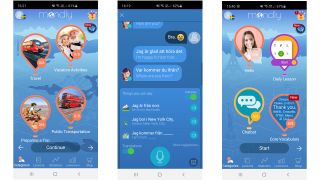One of the more modern language learning apps, Mondly is primarily focused on learning through your smartphone or tablet. Yes, there is an option to learn via Mondly’s website - just using any web browser - but it feels like the best tools for absorbing language are designed to work on touch screens. There are a total of 41 languages available to learn, and 33 native language options to learn them from. So, even if English isn’t your first language, you can take advantage of all the learning opportunities Mondly has.
Mondly is a very slick experience, whether you’re learning on a home computer or smart device, and it’s perfect for beginners as everything is clearly laid out and explained. During this review we tested Mondly on both a smartphone and a PC, and found the experience to be fairly consistent, with just a handful of differences in terms of how you actually interact. We rate this app highly, which is why it features in both our best learn Spanish online courses and our list of French learning apps.
Mondly languages: Learning Method
Whatever language you’re learning, the method for Mondly remains the same. For the first part of this review we set our native language as English, and our learned language as Swedish. Why? Because this reviewer already has a basic grasp of Swedish, and this allows us to test from an intermediate speaker’s perspective. It’s worth noting that you can learn more than one language at once, with an ‘all languages’ Premium subscription, so for the second part of testing we also tested the Spanish course as a complete novice too.
When you first sign up to Mondly - either via the website or the app (available on both the Google Play Store, and Apple Store) - you’re taught how to use the various features, and you’re invited to tell it why you’re learning, choosing from a variety of options like ‘travel’, ‘business’, and ‘romance’.

The method Mondly uses is best described as ‘a bit of everything’. You take lessons in whatever subject you want to know about, and start with basic vocabulary and phrasing. Mondly introduces you to four core words in the first ‘question’, which are then used in most of the following questions in that lesson. So, for example, if you’re learning about colors then you first learn the translations for things like yellow, white, green, and blue. Then the subsequent questions ask you to work with phrases like ‘Snow is white’ and ‘The sky is blue’, allowing you to place the words you’ve learned into an everyday context.
One of the things Mondly does especially well is catering to as many learning styles as possible with each lesson. Each question features the written phrase to translate, a verbal reading of the phrase, and - in most beginner lessons - a picture too. As you learn more, you’re given fewer clues, but if you’re following the lessons logically, the learning curve is pleasingly gentle. There is a lot of repetition here, which is handy for beginners, although it’ll likely be too much for anyone more experienced. Other language apps scale lessons for intermediate and advanced learners, but Mondly doesn’t really adapt too much.
Mondly languages: Features
In addition to regular lessons, there are a handful of other ways to learn. A ‘Core Vocabulary’ module helps you top up with the basics whenever you need, and there is a daily lesson to teach you about subjects you may not have covered with your lesson plan. For example, we started off focusing on travel phrases, but our first daily lesson was all about clothing. It’s a nice idea, and helps expand your vocabulary, but it does create difficulty spikes in your learning. Sure, this will challenge committed learners, but may frustrate anyone fitting in language lessons in their spare time.
Another neat feature is the Chatbot. This helps you to simulate typical conversations in the language you’re learning, as you chat with a bot. We had mixed experiences here, and it works far better on a phone. While it’s great to simulate conversations, and you’re given some sample answers, the accuracy of the chat is often questionable and it can often throw phrases at you that are beyond your current knowledge. Again, it can either be seen as a challenge or a frustration, but we think it’ll be intimidating for total beginners.

The Chatbot highlights the effectiveness of the voice recognition features. We looked at a bunch of user reviews, and tested this ourselves on several devices, and found it to be… just fine. Some people have issues with how well it recognizes their pronunciation of words, and we found that it is far from perfect. However, it manages to accurately pick up most of what you’re saying on both PCs and smart devices (we found the phone mic on our Samsung Galaxy most effective), and - crucially - you have the option to skip the speaking part of all the main lessons.
Our main problem with the smartphone / tablet version of Mondly is that the ‘Check’ button disappears annoyingly frequently, forcing you to repeat the question to resolve the issue. It’s irritating, but other users have noted it, so we suspect it’s only a matter of time before the bug is fixed.
Mondly languages: Is it good for beginners?
In a word: yes. Mondly introduces the language gently to beginners and, providing you stick with the basic lessons and vocabulary catch-ups, it flows really well. There are loads of cues to help you get to grips with the language and feel successful from the start, but it does ramp up the difficulty as you get deeper into each subject area.
It’s worth noting that this learning is very vocab and phrasing-based, and doesn’t really explain the fundamentals of structure and grammar. If you really want to get a sense for how a language works, and the rules of sentence structure, you’ll find Mondly lacking. However, if you want a basic understanding of your chosen language, with a view to becoming fluent at a later date, it’s a good start before you graduate to another software.
Beginners will also appreciate the gamification of the learning process. In the same style as apps like Duolingo, Mondly rewards you with points for finishing lessons, gives you a star-rating for each one, and lets you know how many words and phrases you have learned. You can even compete against friends (although this feature feels like a gimmick), and check your standing on the local leaderboard. You’re occasionally rewarded with little trinkets, like a crown, if you’re doing well. While it’s motivating, these rewards are quite shallow. You’re also given virtual pats on the back for logging in for multiple days in a row - again, ideal for beginners, but it’ll mean far less to intermediates or above.

Mondly languages: Cost and value
What you’re getting here is an app that is ideal for phrasing and vocabulary, which is best for pure beginners, frequent travelers, and business-persons who don’t need to become fluent. As such, the price is reflected in this. You can choose to pay $9.99 per month for a Premium subscription, or you can buy the full 12 months and get a single language course for $47.99. If you want to commit to a full, lifetime subscription across all languages, that will cost you an eye-watering $1999 at full price. At time of writing, though, that price is 95% off (so sits at $99).
These are prices that compare favorably to other, more involved language learning softwares, like our top pick - Rosetta Stone - but we still think you get better value from these competitors if you want to fully learn the lingo. Why? If you’re spending these prices to learn a language, you expect a more complete understanding of it than Mondly can provide.
We think Mondly is best used for basic language learning, like vocab and phrases, so think it’s better value on a monthly or yearly basis, for a single language. If you want to try before you pay money, Mondly comes with a 7-day free trial. Looking to further your skills in a language you already know? Try using one of the best online tutoring services instead, as these sites match your skill level with a live tutor.

Should you buy Mondly languages?
We like Mondly as a platform for beginners, and anyone who wants to learn a new language in their spare time, around another job or activity. It’s perfect for phones and smart devices, and makes it easy to learn using all their capabilities. Sure, the app itself has problems, but we love the use of touch gestures, mics, and the portrait format as part of the learning process. It’s good on a normal PC, but not quite as slick.
The lack of formal learning around how language is structured will be an issue for people looking to go fluent, but as a companion for traveling and business use, Mondly does the job really well. It’s reasonably priced, feels very modern, and the customization and gamification provides a little extra incentive to keep logging in. Sure, not all the features are satisfying to use, but there’s enough here to make sure you progress well in all areas of language learning.

